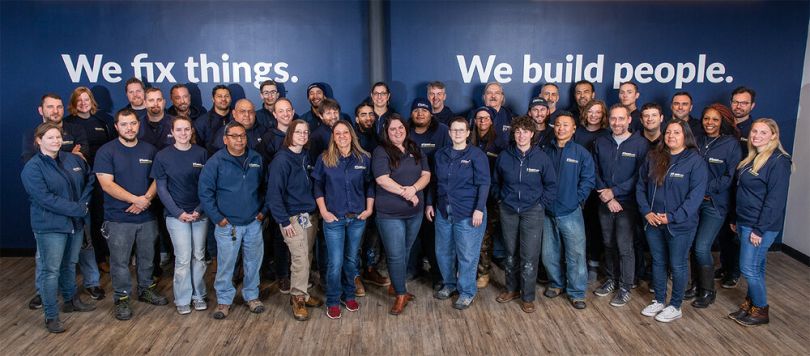Mike Evans spent a decade laying the foundation for the modern gig economy. In 2002, he co-founded Grubhub, the on-demand food-delivery behemoth. He led the company’s operations all the way through its eventual merger and IPO. Then, in 2014, he walked away.
Three years later, Evans founded a new startup, Fixer, which lets users schedule a handyperson for home repair via text. He didn’t want it to be “Grubhub, but for leaky faucets,” though. In fact, he didn’t want it to look like a gig economy company at all.
“The gig economy is a dumpster fire, and it’s not good for the people who are in it,” Evans told Built In when he launched Fixer.
The startup doesn’t rely on independent contractors. All its handypersons — currently more than two dozen in total — are W-2 employees, trained in house.
It’s a radically different arrangement than the gig approach, which uses an algorithm to connect buyers and 1099 workers on a marketplace — a model with an uncertain future in California, where many gig companies are based.
But does it work? Built In caught up with Evans to ask him about his experience building a different kind of service platform.
This interview has been edited and condensed for clarity.

What makes Fixer different from a gig-economy company?
All of our employees are W-2 employees with full benefits and equity in the company. And they’re also engaged in ongoing training; there’s a continuous education element to the training period. And at some point, they become the trainers, they have enough experience that they are then sharing their skills with others.
The pay is good, and the pay is consistent. We don’t furlough people or let them go in the winter when we hit doldrums. We manage demand on their behalf and take the risk out of that.
And then there’s a team approach. They have coworkers they can rely on, who have skills, who they can learn from, who they can teach and who they can vent to if they’re just having a tough day — which is not the common experience for the independent handyperson (who is very skilled, by the way).
Our mission is we fix things, we build people. If the experience isn’t good for the actual workers, then we’re not achieving the goal of our company. It’s as important as making profit for the shareholders. And in fact, the fixers are shareholders, through an option program.
How does hiring and training work at Fixer?
We find people who have aptitude and who show the characteristics that line up with our core values — they’re respectful, safe, good communicators, hard workers. And then, with that aptitude, we can train people. Our training program is 90 days, and they enter a one-year apprenticeship after that.
The first thing we do is train them on soft skills, customer service, how to use our software, things like that. Then we train them on the hard skills, how to hang something on the wall, fix a toilet, change out an electrical socket. Within a week after that, we then send them on a job, where they’re being supervised by another fixer. And they very quickly get to the point where they can just do it by themselves.
We aim to be a trade school disguised as a tech startup. We’re not accredited yet, but we’re working on it.
We picked this model because the supply of skilled workers is absolutely insufficient for the demands that homeowners have — and that’s true from both a quantity and quality perspective. The way we solve that problem is we train them ourselves. And there’s no way for us to provide the service without also providing a community benefit, which is an entry path into the trades.
Do fixers stick around?
This is kind of weird: Our goal is that they graduate from Fixer. We’re an entry path into the trades. We’re trying to reboot trade education in the United States, and part of the way we do that is by intentionally having a bit of a revolving door.
So somebody comes, they learn the skills, they enter the trade as a part of Fixer, they’re with us for a few years and they eventually move into a more specialized trade. Those specialized and commercial and industrial jobs tend to pay more. So if we can launch people into that, it’s great for them and it’s great for our business. It’s an amicable parting of the ways.
Is it easier hiring contract workers as opposed to W-2 employees?
Hiring is just as hard on both sides, provided you’re not cutting corners. Retention is easier on the W-2 employee side. So there’s an advantage there, and there’s especially an advantage if your employee is somebody that you have to invest a lot in from a training perspective. Retention actually becomes way more important than saving, whatever, 12 percent of what you’d be paying them if they were a gig economy worker. So yeah, it is a little bit more expensive to have W-2 employees. But is it really, when you look at the cost of hiring and the cost of training, and how much turnover is really costing a company? I make the argument that an employee-based delivery network for a food delivery company could out-compete a gig economy one. But I’m not in that business anymore.
You wanted to start a business that makes a positive social impact. How do you balance that with the need to drive growth and revenue?
The business has been created very intentionally to benefit both investors and our stakeholders. And those two things are actually of equal importance in our company charter. We’re a public benefit corporation, which is a hybrid between a for-profit and a nonprofit, and we have an equal commitment to both of those groups. So sometimes we do things that benefit our community, and sometimes we do things that benefit our investors — and we can choose between the two. But the key with an impact-based company is that the model itself needs to be such that you’re not choosing between the two in tension.

What’s wrong with the gig economy model?
It’s very easy to treat the products we acquire from the gig economy as disposable. And when that product is a person, we start to think about people we engage with as disposable. That’s true with Uber drivers more than it was ever true with taxi drivers.
From a societal perspective, the disposability of workers is incredibly problematic. I think that happens with Grubhub drivers, with Uber drivers and with TaskRabbit folks. You think of it as so transactional that the transactional nature of it becomes disposable.
Disposable — from the perspective of the company, or the purchaser?
The answer to your question is yes. The companies think of gig economy workers that way, and so do consumers. And it’s really problematic.
When a gig economy worker goes to the emergency room [without insurance], the community pays for that. And so it creates an unfair advantage for gig economy companies, because it requires subsidies by the communities in which they work. I just don’t know that our communities should accept that, because they haven’t consented to it.
In terms of the workers themselves, the flexibility that the gig economy provides — the ability to have a side hustle — that’s the best part of it, right? But when it becomes a 40-hour job without consistency or guarantees or benefits, the benefits are not outweighing the detriments associated with it.
The idea that you can’t just have a part-time worker who has a flexible schedule is an absurdity. Like, of course you can do that. If you want to put the energy into it, then you can. It’s simply the case that the large gig economy companies don’t want to put the energy in.
Even so, some of the large gig economy companies struggle to turn a profit. How come?
I agree: How? I don’t get it.
The amount of money that those companies pay for customer acquisition has escalated to the point where you’re growing at X percent per year and spending — I don’t know what the actual customer acquisition costs are — $70 to $100, but if you spent zero on customer acquisition, you’d be growing at 80 percent of X per year.
The thing that’s really driving the need for those costs is the public markets driving the need for quarterly growth. Not, “Oh, we could grow at a little bit less of a rate and have margins that were four times as high.” Public markets don’t really reward margin, they reward revenue growth. There’s something about the ownership structure that drives poor decision-making from a consumer acquisition perspective.
I think there’s inefficiencies in the business. They can have higher margins, but they would have to sacrifice growth to do it. And that’s not what the ownership structures want.
To turn the discussion back to Fixer: Is the trick, then, just not to get too big, and to partner with people who are patient?
Our venture capital investors are expecting venture returns, and our goal is to deliver them. But venture returns can be 80 percent year over year for 20 years and still be pretty damn good, right? It doesn’t have to be 200 percent for five years and then 0 percent after that.
The idea of building a long-term, high-growth business is something that I’m super interested in. I’m not interested in building a long-term, slow-growth business.
Businesses that do good, do better. I really think that’s true. The intentionality and thoughtfulness it requires to think about how to serve multiple constituencies ultimately builds longer-term businesses with more loyal customers who you serve better, and, ultimately, are better for the community and, at the same time, that’s also great for shareholder return. There’s room to do both.
From a consumer standpoint, what differentiates Fixer from alternatives, whether they are through an app or the yellow pages?
Think about the experience the consumer has to go through with the yellow pages: They pick somebody at random, they call that person, the call goes to voicemail, and then two days later they have a 30 percent chance of getting a call back. Then it might take that person two to four weeks to show up. And that’s all related to the core underlying problem: There are not enough people to do the work, because most of the trade schools have closed. So the consumer experience is terrible.
By having a product that we’ve created, where you text us, we text you back immediately, find out what challenge you have, and then assign a technician that we’ve already vetted to come out and do the work — as opposed to you have to do the vetting about whether or not this person in the yellow pages or on TaskRabbit can do the work — that customer experience is so far superior. And that’s why we have such high repeat purchase rates and high referral rates.




